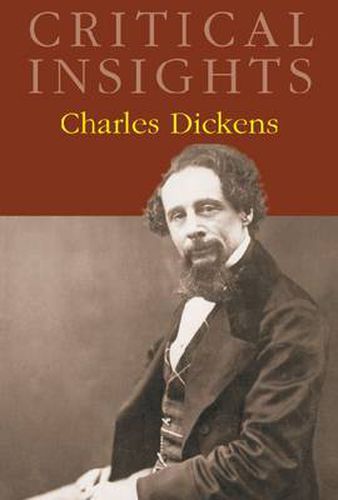Readings Newsletter
Become a Readings Member to make your shopping experience even easier.
Sign in or sign up for free!
You’re not far away from qualifying for FREE standard shipping within Australia
You’ve qualified for FREE standard shipping within Australia
The cart is loading…






This volume in the Critical Insights series brings together a variety of new, classic, and contemporary essays on Dickens’s most widely read works. Eugene Goodheart, Edytha Macy Professor of Humanities Emeritus at Brandeis University, introduces the collection with a celebration of Dickens’s dramatic and imaginative powers and of his characters’ capacity to achieve selflessness in love despite their grim surroundings. Elizabeth Gumport, writing for The Paris Review, reflects on Dickens’s realism and his childlike awe at the world and people around him.
For readers studying Dickens for the first time, a brief biography will acquaint them with the essential details of his life, and a group of introductory essays will give them the background necessary for studying his work in greater depth. Shanyn Fiske describes how Dickens’s novels helped Victorian readers understand and reconcile themselves with the rapid industrialization and urbanization of their time, while Laurence W. Mazzeno surveys the ups and downs of Dickens’s critical reputation. Nancy M. West then examines how Dickens interweaves reality and fantasy in Oliver Twist and other novels.
The volume continues with a selection of classic and contemporary essays that will help readers gain a deeper understanding of the critical issues surrounding Dickens’s work. Oliver Twist is treated by John M. Duffy, Jr., who explores the relation between the young orphan and his urban society. Alan P. Barr examines David Copperfield, focusing on the price paid by the eponymous hero as he matures. Julia F. Saville draws on John Stuart Mill’s essay On Liberty to examine the eccentric Dickensian character in a reading of David Copperfield. G. Robert Stange then reads Great Expectations as a sort of moral fable. Monroe Engel also takes up David Copperfield and Great Expectations, comparing them to show how Dickens’s understanding of success, especially his own success, changed over the course of his life. Bleak House is treated by Robert A. Donovan, who likens its plot to that of a detective novel, and by Michele S. Ware, who uncovers the novel’s mythical dimensions. Patricia E. Johnson demonstrates how the structure of Bleak House replicates the novel’s characters’ own imprisonment. Lionel Trilling’s classic essay on Little Dorrit treats one of Dickens’s perennial concerns-the relation between the individual and society-and declares that the novel’s spiritual impulses make it fine company for The Divine Comedy and Pilgrim’s Progress. Finally, Matthew J. Bolton traces back to Dickens a handful of modernist innovations, such as stream-of-consciousness narration.
Finally, the volume’s appendixes offer a section of useful reference resources:
A chronology of the author’s life
A complete list of the author’s works and their original dates of publication
A general bibliography
A detailed paragraph on the volume’s editor
Notes on the individual chapter authors
A subject index
$9.00 standard shipping within Australia
FREE standard shipping within Australia for orders over $100.00
Express & International shipping calculated at checkout
This volume in the Critical Insights series brings together a variety of new, classic, and contemporary essays on Dickens’s most widely read works. Eugene Goodheart, Edytha Macy Professor of Humanities Emeritus at Brandeis University, introduces the collection with a celebration of Dickens’s dramatic and imaginative powers and of his characters’ capacity to achieve selflessness in love despite their grim surroundings. Elizabeth Gumport, writing for The Paris Review, reflects on Dickens’s realism and his childlike awe at the world and people around him.
For readers studying Dickens for the first time, a brief biography will acquaint them with the essential details of his life, and a group of introductory essays will give them the background necessary for studying his work in greater depth. Shanyn Fiske describes how Dickens’s novels helped Victorian readers understand and reconcile themselves with the rapid industrialization and urbanization of their time, while Laurence W. Mazzeno surveys the ups and downs of Dickens’s critical reputation. Nancy M. West then examines how Dickens interweaves reality and fantasy in Oliver Twist and other novels.
The volume continues with a selection of classic and contemporary essays that will help readers gain a deeper understanding of the critical issues surrounding Dickens’s work. Oliver Twist is treated by John M. Duffy, Jr., who explores the relation between the young orphan and his urban society. Alan P. Barr examines David Copperfield, focusing on the price paid by the eponymous hero as he matures. Julia F. Saville draws on John Stuart Mill’s essay On Liberty to examine the eccentric Dickensian character in a reading of David Copperfield. G. Robert Stange then reads Great Expectations as a sort of moral fable. Monroe Engel also takes up David Copperfield and Great Expectations, comparing them to show how Dickens’s understanding of success, especially his own success, changed over the course of his life. Bleak House is treated by Robert A. Donovan, who likens its plot to that of a detective novel, and by Michele S. Ware, who uncovers the novel’s mythical dimensions. Patricia E. Johnson demonstrates how the structure of Bleak House replicates the novel’s characters’ own imprisonment. Lionel Trilling’s classic essay on Little Dorrit treats one of Dickens’s perennial concerns-the relation between the individual and society-and declares that the novel’s spiritual impulses make it fine company for The Divine Comedy and Pilgrim’s Progress. Finally, Matthew J. Bolton traces back to Dickens a handful of modernist innovations, such as stream-of-consciousness narration.
Finally, the volume’s appendixes offer a section of useful reference resources:
A chronology of the author’s life
A complete list of the author’s works and their original dates of publication
A general bibliography
A detailed paragraph on the volume’s editor
Notes on the individual chapter authors
A subject index